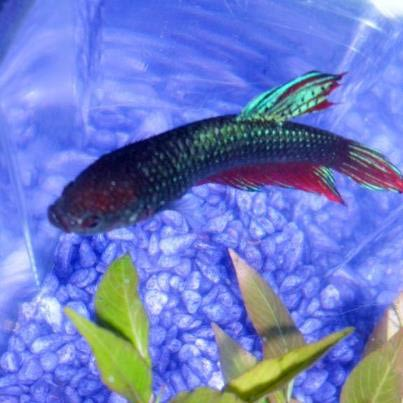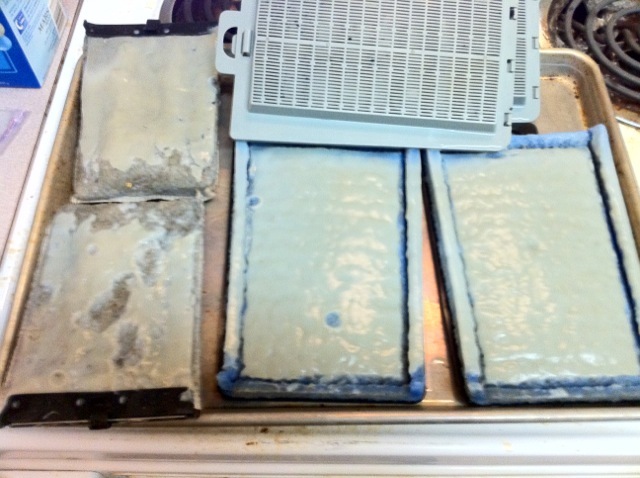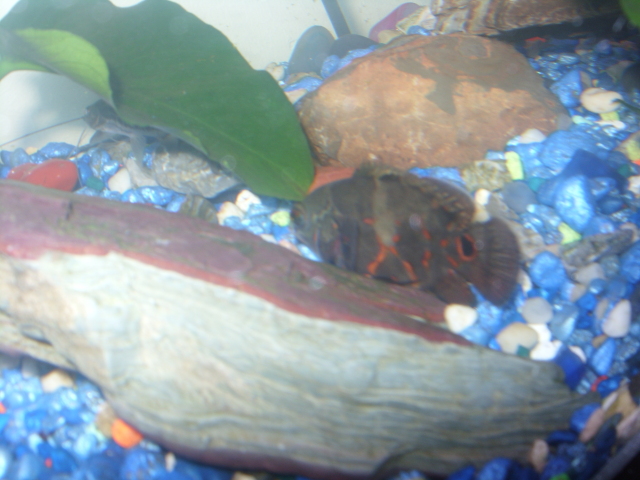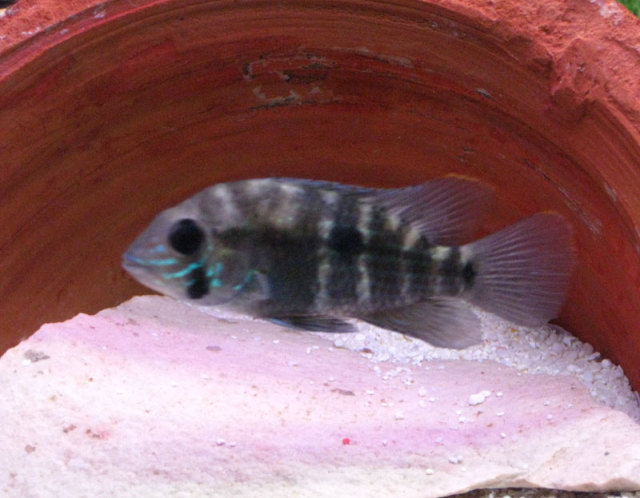Questionwell i need to know how to take care of this particular fish. so could you tell me how to? and could you tell me how aggressive this fish is? i need to know the basics on how to take care of fish. i also need to know what temperature the water needs to be.
AnswerHi Will;
All Parrot Cichlids need a minimum of 30 gallons for the first couple of years. After that they will need a 55 or larger. They get pretty big (up to 10 inches) and like other cichlids are pretty messy guys. Give them plenty of room. They aren't terribly aggressive but be sure you keep them with fish that they can't eat in a large enough tank for all to be happy. I had mine with lots of different fish like silver dollars, giant danios, gouramis, oscars, jack dempseys, plecostomus, large angels and catfish of many kinds.
For filtration, avoid undergravel systems because parrots like to dig up the gravel and move it around. Without an even distribution of gravel the flow of water and oxygen is not consistent. This makes the undergravel useless most of the time. The best for big fish like these is a power filter or canister filter.
Be sure you have a good reliable heater that is the proper size. The water should be 78 to 80 degrees all the time. Your tank needs 5 watts per gallon of heater power for every gallon of tank water in a normal temperature home. If your house tends to be on the cool side, get a little higher wattage heater. The types of heaters that are totally submersible with suction cups to hold them in place are the best. Big fish like parrots will bump them or sometimes even fight with the heater and break the heater or aquarium glass. Secure it to the side with suction cup heater holders to keep them from moving. Some submersibles have an automatic shutoff in case you forget to unplug the heater during a water change or while removing the heater from the water. This is a great safety feature. The heater can crack or shatter if it is still heating while out of the water. Especially if you are putting it back in the water or if you are adding water to the tank and it touches the hot heater tube. Yikes! Pretty dangerous for both you and your fish.
Use rocks for decorations and artificial plants with weighted anchors if you decide to use any plants at all. (Cichlids destroy live ones) Driftwood is good to use. Make caves they can hide in with rocks and driftwood.
Keep in mind that all parrots are a hybrid fish (cross breeds and not found in nature) and the jellybean variety are usually a dyed or painted fish. This means they are artificially colored. For this reason, your fish may not reach it's full potential size and may have a considerably shorter lifespan due to it's treatment to get those colors. Here is info on it if you want to know how it's done and which fish are affected;
http://freshaquarium.about.com/cs/beginnerinfo/a/paintedfish.htm
It is a very cruel process so most hobbyists and fish experts frown on the continued breeding of these poor fish. Most die in the process (80%) and those that do survive usually have permanently weak immune systems.
To help keep your fish healthy in spite of this, be sure to keep the tank very clean, don't overfeed and don't overcrowd the tank. Make 25% water changes every week while vacuuming the gravel. Proper maintenance is the key ingredient to healthy fish of any kind.
Here is my article on new tank syndrome to help you if your tank is new;
**********
New Tank Syndrome or Break-in Period
So you have a new tank and you filled it up, put the filter together, mounted the heater into place and turned on the lights. You have all the plants and decorations where you want them....
You are ready for fish.
But, your filter is not ready for a full tank of fish yet.
The filter is running and moving the water and cleaning out crud, right? Of course!
But a very important part of your filter is the part you can't see. An aquarium filter removes the larger visible stuff, but it also must remove the dissolved fish waste that turns into ammonia in the water. To do this, special bacteria must grow in the filter system and on the particles of gravel in the bottom of your tank. This process occurs even on a limited scale in little fish bowls that have no filter in them.
This is "New-Tank Syndrome" or the "Break-in Period". The entire process takes 6 to 8 weeks to complete because these "nitrifying" bacteria grow quite slowly.
Start off with only one or two hardy fish (no more than 2 total inches of fish) for every ten gallons of water and don't add more until the 6 to 8 weeks has gone by. Hard to be patient, but it is worth it to keep your fish alive and healthy. As a matter of fact, the bacteria cannot develop without fish in the tank. You can let that tank sit forever without fish in it, but as soon as the first fish goes in the process begins. Avoid changing the filter pads during break-in. This removes the bacterial colonies that are essential to a balanced aquarium. You can rinse the filter pad out in a container of aquarium water. This will preserve most of the bacteria colonies while still allowing your filter to flow freely. Even using bacteria additives and water conditioners when you first set up the tank will not make a tank begin the cycle by itself. If there are no fish to provide food (fish waste) for the bacteria, the beneficial bacteria cultures will die and you will have to start the colonies all over again once fish are added to the tank. Once the tank has completed the initial cycle, you can change the filter pads every 4 weeks or so. But for now, just rinse them.
Feed your new fish VERY lightly. Any excess food will cause additional waste your system cannot afford to have right now. If you see food floating around or lying on the plants and gravel after five minutes, too much food is going into the tank. Cut back a little each time you feed until it is ALL gone 5 minutes after you feed them. Feed them once a day.
During this "break-in period" your tank will become cloudy and milky looking. You may have to tolerate this for the entire break-in period but it is only temporary. Changing 25% of the water three times a week until the break-in period is over helps a great deal. Changing water reduces the ammonia and nitrites that rise while the bacteria continues to multiply. If ammonia and/or nitrites become too high, your fish will become stressed and possibly die. Use a good water conditioner when you replace the water and make sure it is the right temperature to avoid shocking your fish.
When the break-in is over after 6 to 8 weeks and there are no nitrites or ammonia present in the water you can slowly add more fish. Add one or two every week until you reach the desired population. This allows the bacteria to adjust to the new population every time before adding more. Monitor the nitrites and ammonia to be sure they don't come up. If they do, make a 25% water change and check them again. Don't add the next fish until the levels are down again.
The safe maximum population for any size tank is one inch of adult fish for every gallon of water in the tank. Do some research to be sure of the fish you are interested in. Even though they are small when you buy them, you have to base your population calculations on full-sized adult fish. Many hobbyists have up to two inches per gallon but this can be risky. If a water quality issue arises or a disease occurs it will spread fast and furious in an over-populated tank. In any case, 25% water changes every week to two weeks are absolutely essential for the health of your fish.
Following these guidelines will help you get your new tank on the right track.
**********
Followups welcome
At Your Service;
Chris Robbins
Come on over and join us on the freshwater fish forum at About.com to get even more information too;
http://freshaquarium.about.com/od/questionsanswers/a/naavigateforum.htm
My member name is ChrisR62. See You There!

 Goldfish with Dropsy
Question
DROPSIDIC goldfish
Hi my Gold fish has dropsy.
Goldfish with Dropsy
Question
DROPSIDIC goldfish
Hi my Gold fish has dropsy.
 Male King Betta
Question
Spike
Hi, First of all I want to thank
Male King Betta
Question
Spike
Hi, First of all I want to thank
 Urgent - Fish are really sick
Question
Gray slime on filters
My mom passed away and I
Urgent - Fish are really sick
Question
Gray slime on filters
My mom passed away and I
 My sick oscar fish
Question
Sick Oscar
I recently purchased an oscar whic
My sick oscar fish
Question
Sick Oscar
I recently purchased an oscar whic
 identifying my fish
Question
1
Hello, I would like to know if this fish is
identifying my fish
Question
1
Hello, I would like to know if this fish is